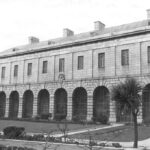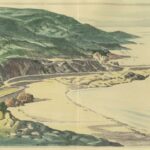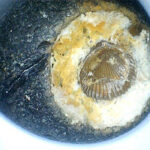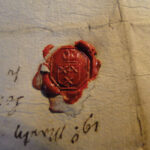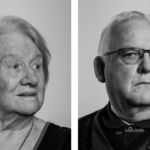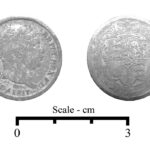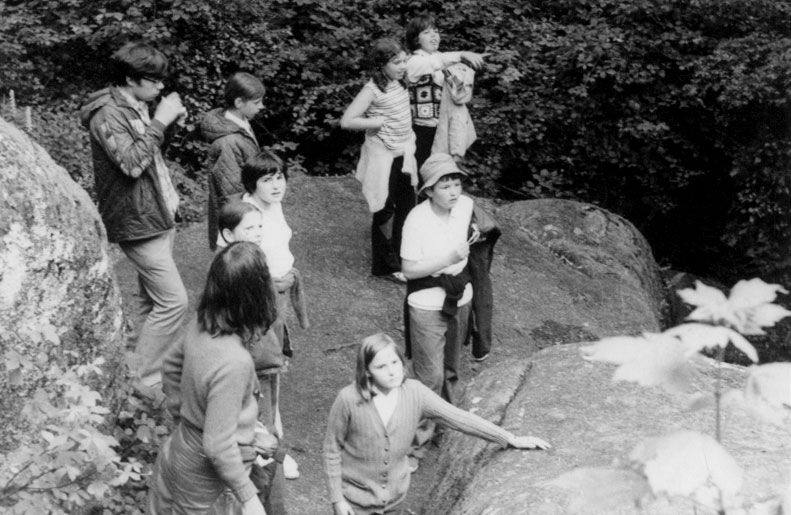by Rory Hill, Société Jersiaise Millennium Scholar
28 October 2024
I am working on a project concerning the food parcels that were sent from Canada to the Channel Islands through the Red Cross in the last months of the Second World War. Whilst the arrival of the SS Vega and the distribution of her cargo of Red Cross food parcels is well known and still in living memory in the islands, less is known about the circumstances in which they were put together on the other side of the Atlantic. I was lucky enough to receive the support of the Société Jersiaise through its Millennium History Award, which helped to pay for an archival research trip to Canada early in the summer. That trip was also supported by an internal award from my current institution, Oklahoma State University.
In the lead up to fieldwork, I consulted the catalogues of, and made contact with, all major provincial and national archives in Canada to assess the relevance of their collections and ascertain their availability. From that exercise, I established a list and built an itinerary of archives to visit in person. It was necessary to contact all of these archives because in 2016, the Canadian Red Cross disbanded its central archive, and its rooms full of historical documents got dispersed to libraries and archives throughout the country. In some cases, these collections have not yet been catalogued, rendering access to them very difficult. The Canadian historian Sarah Glassford was the last scholar to access the central archive when it was intact – using it to write her excellent volume Mobilizing Mercy: A History of the Canadian Red Cross – and I have been lucky enough to correspond with her over the last year. She has been a great help in tracking down documents that are of relevance to this project, sometimes in unexpected places. I also received some documents in digital format, sent by kind archivists here and there.
From 10 July to 31 July I visited the following archives in person: Archives of Ontario (Toronto); Toronto Public Library (Toronto); Library and Archives Canada (Ottawa); Canadian War Museum (Ottawa); Bibliothèque Nationale de Québec (Montréal); and Archives of Manitoba (Winnipeg).
I took numerous pages of notes, and over a hundred digital photographs of the documents consulted, and I am currently working through all of this. I am hoping to publish the findings next year, likely in a short book format. I have also applied to present my findings at the 91st annual conference of the Society for Military History, in Mobile, Alabama, in March 2025, which will allow me to gather valuable feedback from interested historians.

Consulting a book of local newspaper clippings from the Second World War period at the Archives of Manitoba, Winnipeg
There have been some interesting initial findings. The first thing is that I had, naively and vaguely, assumed that the food parcels had been sent expressly from Canada to the Channel Islands. Société historians will likely already know what I learned early on in the research, which is that the parcels were originally intended for Canadian and Allied POWs at camps in continental Europe. Tens of thousands of these were stockpiled in Lisbon, and some in transit in Marseilles and Geneva, in late 1944, when the desperate requests for aid came from the Bailiffs of Jersey and Guernsey. The decision was made between the British, International and Canadian Red Cross organisations to re-allocate a large portion of the parcels that were already in Lisbon for civilians in the Channel Islands, and these were the parcels that the SS Vega delivered over and again until May 1945. This is also why a small number of the parcels that landed in Jersey had been assembled in the USA, New Zealand or Australia; because some of those had made it to that central stockpile in Lisbon and got re-purposed for us, like the Canadian ones had.

Canadian Red Cross magazine showing containers of food parcels getting loaded onto a ship bound for Europe. Some of these likely made it to Jersey.
The second thing is that the preparation of these food parcels – intended for POWs, but ultimately also serving to relieve civilian hunger – was a massive undertaking within Canada. It took place within a wider set of activities that the Canadian Red Cross undertook throughout the War, which included feeding and caring for returning servicemen and their families, fielding queries from around the world regarding displaced persons and POWs, gathering blood and serum donations for wounded soldiers, training and despatching nurses to Europe, and providing advice to mothers on how best to feed their families at a time of rationing. Indeed, a major concern with food and nutrition led the Canadian Red Cross to sponsor research into how to pack the most nutrition into the eleven-pound food parcels such as those received in Jersey. The cost of these different products – including tinned prunes, powdered milk and tinned salmon – was also carefully itemised, and extensive accounting records show how the money for these parcels was raised and spent. There was also a chocolatey surprise that led to an embodied experience for this researcher in Winnipeg, which will be recounted in the book!

Foods packed were meticulously itemized, and this graph from 1945 demonstrates the variety included in the food parcels, and some detail on how they were paid for.
The packing of the parcels themselves was almost entirely a volunteer effort which, at its peak in early 1945, was happening every day across warehouses in six cities across Canada, from Montreal in the east to Winnipeg in the west. The vast majority of those doing the packing were women. A news article from Winnipeg at the time celebrates the Fordist production line by which the goods were packed over and over again into the cardboard boxes, and in the photographs of that article we see some older men helping to move the finished boxes onto trucks, bound for ports and eventually Lisbon. Canadian Red Cross volunteers – through its many provincial and smaller divisions – also knitted clothing for Allied sailors and airmen, and for many civilian populations in Europe. Indeed, documents in the archives show fundraising events taking place in Canadian cities for particular European populations whose diasporas were living in Canada – such as the Finns and the Greeks – though I couldn’t find anything similar specifically for the Channel Islands (which is not to say that it didn’t happen).

Detail from news coverage of the Red Cross food parcel packing plant in Winnipeg, 1944.
In general, the Channel Islands were not as extensively discussed in the Canadian Red Cross documents or news coverage as I had hoped. Historians know that archives cannot record everything, and it is hard to get at what was on people’s minds; the volunteers’, for instance, as they did the work of packing food parcels day after day. It is practically impossible that none of these volunteers had Channel Island ancestors, given what we know about Jersey and Guernsey emigration to the Gaspé coast and elsewhere, but it may be that they weren’t aware that their parcels were going to civilians in those islands. In the documents I saw, there was a great focus on helping Britain in general terms; it was often described as the mother country and there was, for example, a ‘Jam for Britain’ campaign which was not replicated for any other country. Of course, under conditions of Occupation, the Channel Islands could not enjoy the bounty of jam made from apples and plums in British Columbia, honey from the prairies, or maple syrup from Québec, which went to those in mainland Britain suffering through the Blitz, rationing, and other privations. Occasionally, though, buried deep in a folder or in a column of a newspaper, there was mention of what Churchill would memorably call ‘our dear Channel Islands’. There were, for example, several letters received and kept on file by the Canadian Red Cross. One was written by a Guernseyman in 1945 and addressed to the Canadian Prime Minister, thanking him for the country’s generosity in the shape of the food parcels. Incredibly, the next sheet in that folder was…the Prime Minister’s reply! Their exchange was also picked up in the Canadian press. Another letter from Jersey, reproduced in the News Bulletin of the Ontario Division of the Canadian Red Cross, read: ‘These parcels definitely saved our lives, so let the Canadians know about this and tell them how grateful we are.’ And there was the full report of a visitor sent to the islands from Red Cross HQ in London very shortly after Liberation, which painted a vivid portrait of the islands at that time. Coming across documents such as these certainly produced a frisson, and their contents will be shared in the book to come.

The ’Jam for Britain’ campaign was another source of food-based solidarity organized by Canada during the War, and reported in Red Cross newsletters.
I have remained in contact with several historians (including at the Société) throughout the year, and I intend to write something that will place the story of the food parcels coming to the Channel Islands within its wider context. That context includes a multinational Red Cross organisation, a changing Canadian society, a bountiful North American agriculture, the grim realities of war, and the numerous acts of solidarity that so thankfully emerged. I am very grateful for the support of the Millennium History Award, and I look forward to sharing this research more fully with Société members next year.

The Archives of Manitoba were only open Monday to Friday…so at the end my trip I had a day in Winnipeg to take part in the Canadian pursuit of kayaking!

